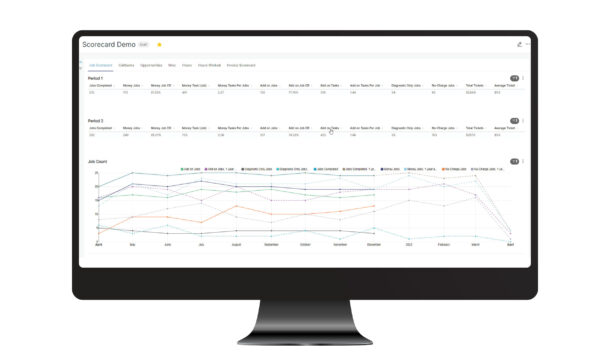Key Performance Indicators (KPIs) can be a very valuable measurement tool for the overall health and success of your business when tracked and interpreted correctly. Because businesses are only as successful as their employees, it’s imperative for owners and managers to set a standard of KPIs and follow through on measuring their progress. Doing so will help you foster more employee satisfaction and ensure more customer satisfaction as well.
In the home service world, there are many different types of important KPIs. Let’s focus on a few of the top ones you can use to track customer service teams and technicians. The lists below are focused on areas that will help your business increase average ticket size and revenue. Once tracking, you may be able to identify areas where more training or strategic staffing will benefit you most.

Customer Service Team
As the first interaction a customer or potential customer will have with your business, your Customer Service Representatives (CSRs) must provide the best possible customer experience. When your customers have an excellent experience right from the start, it typically pays off in increased revenue and customer retention. A few KPIs to track:
- Average Response Time – Track how long it takes your CSRs to answer a customer inquiry. Whether by phone call, email, or text, you don’t want to keep your customers waiting a long time to hear from you. If the average response time is getting longer each month, you may want to add another CSR to lighten the workload.
- Customer Satisfaction – Through surveys, feedback forms, or ratings, you can solicit feedback from your customers on how satisfied they are with the experience they had with your CSR. The higher the score, the happier your customers are with your customer experience and the more likely they will recommend your business to a friend or return for repeat business.
- Booked Jobs Conversion Rate – When your CSRs are scheduling a high number of jobs that result in completed, revenue-generating jobs, you have increased revenue and profit. By tracking this performance, you can make informed scheduling decisions that will get your CSRs with the highest booked jobs ratio working during busy times or in an active queue. If you have a CSR who books jobs that are constantly canceled, you can investigate why this is happening.
- Upsell Rate – This metric will tell you how successful your CSRs are at upselling your customers on products, services, or agreements to increase your average ticket size. Track how adept your CSRs are at this and offer training in the art of the upsell; it’s time and effort that should pay off quickly.
Technicians
Optimizing technician performance out in the field is key to making sure customers are happy and strategic goals are being hit or exceeded. A few KPIs to track for technicians include:
- Average Length of Repair Time – the rate at which your technicians are able to complete jobs will directly affect the number of jobs done in a day and amount of revenue you make. Once you start tracking, you may be able to identify technicians who would benefit from additional training so they can maximize their daily number of jobs and you can maximize profits.
- Number of Callbacks – When your technicians have to go back out to a completed job to address an issue, it takes up valuable time that could have been spent on a revenue-producing job. Once you start tracking this metric, you will get a sense over time if there are any trends with your callbacks, such as high numbers from one technician or from a particular piece of equipment. Having that insight gives you the opportunity to offer additional training that will address any repetitive issues.
- Average Ticket Size – Upselling can have a huge impact on your profits, but it’s not a skill set everyone has. The key is knowing which of your technicians have those strengths – the ones with a large average ticket size – and scheduling them for specific jobs where they may have the potential to sell a homeowner on upgraded equipment, for example. You could even incentivize your techs to sell more by starting a contest to see who can increase their average ticket size or have the largest ticket size. The prize is two-fold – for the winning employee and for your business.
- Total Number of Opportunities Identified in the Field – Technicians are your front line for identifying future job opportunities. What they notice at your customer’s home – such as potential repair or replacement issues – can give your sales team something to follow up on. Tracking how many opportunities each of your techs are bringing in is important. These are great revenue generators for customers already familiar with your business and how you work.
These are just a few ideas of top KPIs you can start tracking to measure success with your CSRs and technicians. Make sure your business management software is giving you insight into these valuable metrics to help you make data-driven decisions regarding your business.
 Paul Carmody has over 20 years of experience as a senior executive in Software-as-a-Service, technology-enabled services, internet infrastructure, and supply chain/manufacturing industries. He has served as a key executive in five successful exits and one IPO. He is currently President of Successware, an Authority Brands company.
Paul Carmody has over 20 years of experience as a senior executive in Software-as-a-Service, technology-enabled services, internet infrastructure, and supply chain/manufacturing industries. He has served as a key executive in five successful exits and one IPO. He is currently President of Successware, an Authority Brands company.




Join the conversation: